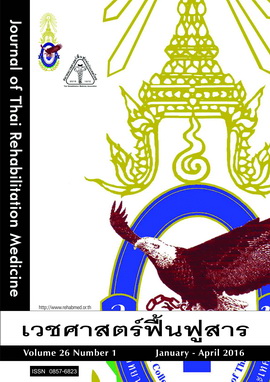ผลจากการฝึกเดินบนสายพานเลื่อนพร้อมการพยุงน้ำหนักตัวกับ การฟื้นความสามารถเดินและการทรงตัวของผู้สูงอายุในชุมชน
ผลจากการฝึกเดินบนสายพานเลื่อนพร้อมการพยุงน้ำหนักตัวกับ การฟื้นความสามารถเดินและการทรงตัวของผู้สูงอายุในชุมชน
Keywords:
walking, balance, fall, body weight support treadmill training, การหกล้ม, การเดิน, การทรงตัว, การฝึกเดินบน สายพานเลื่อนด้วยเครื่องพยุงน้ำหนักตัวAbstract
ABSTRACT
Objective: To study the effects of a partial body weight support treadmill training (PBSTT) program in improving balance, and walking of elderly community-dwellers with a history of fall and perception of poor balance
Study designs: Experimental and comparative study
Settings: Rehabilitation Department, Samrong General Hospital
Subjects: Elderly peoples aged more than 60 years with self-perceived poor balance or a history of fall within six months.
Methods: Training consisted of walking with PBSTT and progressive difficulty 2 times/week for 6 weeks. Participants were evaluated with Berg Balance Scale (BBS), Time Up and Go test (TUGT), gait speed, cadence and step length before, immediate after completion of the training and 6 months later. Data were compared between before and after the training.
Results: There were 40 participants (7 men and 33 women) with average age of 68.6 years. Twenty eight of them reported at least one fall within 6 months prior to the study, and the calculated rate of falls was 1.45 time/person/year. The rate of fall at 6 months follow up was 0.05 time/person/year. Calculated reduction of fall is 95.07%. BBS, TUGT, comfortable gait speed, and average step length after completion of the 6 week training and at 6 months follow up were significantly different from before training data with p value <0.01 and <0.05 respectively. There was a significant statistical difference in cadence before and immediately after training at p value 0.05 but not between before and at 6 months post training.
Conclusion: Six-week or 12 times program of walking with PBSTT could reduce the rate of fall, increase in gait speed and improve balance of community dwelling elderly persons with balance problems.
References
2. Sophonratanapokin B, Sawangdee Y, Soonthorndhada K. Effect of the living environment on falls among the elderly in Thailand. Southeast Asian J Trop Med Public Health 2012; 43: 1537-47.
3. Thiamwong L, Thamarpirat J, Maneesriwongul W, Jitapunkul S. Thai falls risk assessment test (Thai-FRAT) developed for community-dwelling Thai elderly. J Med Assoc Thai. 2008; 91: 1823-31.
4. Kannus P, Niemi S, Palvanen M, Parkkari J. Continuously increasing number and incidence of fall-induced, fracture-as sociated, spinal cord injuries in elderly persons. Arch Intern Med. 2000; 160: 2145-9.
5. Gillespie LD, Robertson MC, Gillespie WJ, Sherrington C, Gates S, Clemson LM, et al. Interventions for preventing falls in older people living in the community. Cochrane Database Syst Rev 2012; 9: CD007146.
6. Cameron ID, Gillespie LD, Robertson MC, Murray GR, Hill KD, Cumming RG, et al. Interventions for preventing falls in older people in care facilities and hospitals. Cochrane Database Syst Rev 2012; 12: CD005465.
7. Grabiner MD, Bareither ML, Gatts S, Marone J, Troy KL. Task- specific training reduces trip-related fall risk in women. Med Sci Sports Exerc. 2012; 44: 2410-4.
8. Pirouzi S, Motealleh AR, Fallahzadeh F, Fallahzadeh MA. Effectiveness of treadmill training on balance control in elderly people: a randomized controlled clinical trial. Iran J Med Sci. 2014; 39: 565-70.
9. Lurie JD, Sagaria AB, Pidgeon DM, Forman JL, Spratt KF. Pilot comparative effectiveness study of surface perturbation treadmill training to prevent falls in older adults. BMC Geriatr. 2013; 16: 13-49.
10. Shema SR, Brozgol M, Dorfman M, Maidan I, Sharaby- Yeshayahu L, Malik-Kozuch H, et al. Clinical experience using a 5-week treadmill training program with virtual reality to enhance gait in an ambulatory physical therapy service. Phys Ther. 2014; 94:1 319-26.
11. Owings TM, Pavol MJ, Grabiner MD. Mechanisms of failed recovery following postural perturbations on a motorized treadmill mimic those associated with anactual forward trip. Clin Biomech 2001; 16: 813-9.
12. Landers MR, Oscar S, Sasaoka J, Vaughn K. Balance confidence and fear of falling avoidance behavior are most predictive of falling in older adults: prospective analysis. Phys Ther. 2015 Aug 20. [Epub ahead of print]
13. Hannan MT, Gagnon MM, Aneja J, Jones RN, Cupples LA, Lipsitz LA, et al. Optimizing the tracking of falls in studies of older participants: comparison of quarterly telephone recall with monthly falls calendars in the MOBILIZE boston study. Am J of Epidemiol. 2010; 171: 1031-36.
14. Steffen TM, Hacker TA, Mollinger L. Age- and gender-related test performance in community-dwelling elderly people: six- minute walk test, berg balance scale, timed up & go test, and gait speeds. Phys Ther. 2002; 82: 128-37.
15. Podsiadlo D, RichardsonS. The timed “Up & Go”: a test of basic functional mobility for frail elderly persons. J Am Geriatr Soc. 1991; 39: 142-48.
16. Berg K, Wood-Dauphinee S, Williams JI. The balance scale: reliability assessment with elderly residents and patients with an acute stroke. Scand J Rehabil Med. 1995; 27: 27-36.
17. Berg KO, Maki BE, Williams JI, Holliday PJ, Wood-Dauphinee SL. Clinical and laboratory measures of postural balance in an elderly population. Arch Phys Med Rehabil. 1992; 73: 1073-80.
18. Bohannon RW. Comfortable and maximum walking speed of adults aged 20-79 years: reference values and determinants. Age Ageing. 1997; 26: 15-19.






